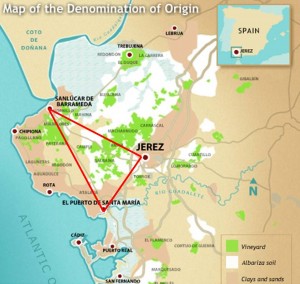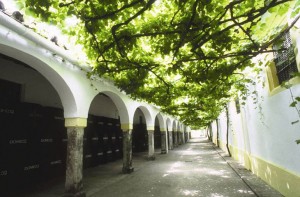Bringing Back the Bodega (Sherry) Part I
15 Sep
Last week we were treated to a great presentation on Sherry from Last Call Consulting partners Katie Stipe and Phil Ward, also owner/operator of Mayahuel, NYC. It was an extensive 4 1/2 hour session covering the history and production of Sherry, a tasting of eight different Sherries, and a discussion about the use of sherry in cocktails. We ended with a chance to hand craft our own cocktails using Sherry. I will attempt to summarize some of what we learned.
The “Sherry Triangle” where the grapes are grown is roughly defined by Sanlúcar de Barrameda, Jerez de la Frontera, and El Puerto de Santa María in south-east Spain. Being one of the southern-most wine producing regions in Europe, the prevailing climate in the area of Jerez is warm and consistent. Summers are dry and there are 300 days of sunshine a year. With the Atlantic to the west, there is sufficient humidity, especially at night when a blanket of fog may rest over the vineyards. These westerly Atlantic winds, called “Poniente”, are balanced by south-easterly hot, dry winds from Africa, called Levante.
Most rain comes in the autumn and winter, a surprisingly high 620 L/year. This is quite sufficient despite the dry summers because of the soil in many of the vineyards. Called “alberiza” it is rich in the limestone/calcium carbonate (up to 40%) left by marine fossils, clay, and silica. This soil sucks up water like a sponge and crusts over in the dry summer, retaining the water below and reflecting a stunning white color. Root systems grow very well in this soil, with 12 m long roots found up to 6 m deep. The soil tops rolling hills, with a soft 10-15% gradient.
Sherry has a long history, with viticulture in the area of production near Jerez, Spain dating back over 3000 years. This production even survived Moorish rule as wine could be used for medicinal purposes and the grapes could be converted to products like raisins. The name Sherry even derives from the Moorish name for the city of Jerez, Sherish.
It has been known as a “traveling wine” from the beginning, having been traded throughout the Mediterranean. Once it became fortified, it was able to travel even further distances. In his famous voyage, Magellan made it the first wine to circumnavigate the globe, spending more on Sherry provisioning than on arms.
The more “recent” history of Sherry dates to the late 1700’s. Consumer tastes in Europe had trended to stronger flavored, aged styles of wine. Producers wanted to meet consumer demand while growers in the Vintners Guild preferred to sell younger wines in order to get their investment back much faster.
In the decades following 1775, producers and consumers won out and the Vintners Guild was abolished. This was the important in terms of Sherry production because fortification was now going to be used for more for stylistic purposes in the aged wines, rather than solely for preservation of younger wines. Also, the Solera/Criadera aging process of blending older Sherries with newer vintages evolved because of the prolonged storage of different vintages and the need for a consistent product for the consumer.
This change in emphasis to aging also resulted in the building of the great Bodegas, with the architecture optimized to create ideal aging conditions while reflecting the prevailing neo-classical style of the day.
Sherry aging requires regulated temperature and humidity, which as we learned is not easy to find in the Sherry triangle if you don’t have modern climate control. Clever design was required to utilize the strengths of the climate while minimizing its difficult aspects.
Unusually high ceilings allow heat to rise. It is then naturally vented through the arch design, out of openings placed high on the east and west facing walls. The height also gives the bodega interior a large volume of oxygen, necessary for the growth of the yeast, or “flor” (which is critical in the Sherry aging process). The high windows, covered with blinds during the day, filter the air and create a consistent and diffuse light, irrespective of the sun’s position.
The rectangular buildings are oriented to allow flor friendly humidity in from the Poniente winds. The orientation also blocks the hot, dry Levante winds and minimizes exposure of the walls to the most intense sunlight. Porous walls let in the humidity but because they are thick and thermally inert, they block out the summer heat. In the summer, vegetation on the south walls protects from direct sunlight. In the winter, with the leaves gone, the sunlight is able to warm the whitewashed walls, which in turn transfer the heat into the bodega during the cool nights. Finally, the floors are covered with porous albero earth. When saturated with water, it lowers the Bodega temperature and keeps it cool by slowly releasing water into the air.
Part II will touch on the production of Sherry prior to aging.





No comments yet